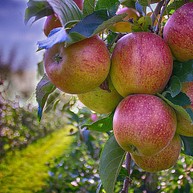Tens of millions of red land crabs live on Christmas Island. They are the Island's keystone species, because they play a vital role recycling nutrients and shaping and maintaining the structure of the rainforest.
At the beginning of the wet season (usually October / November), most adult Red Crabs suddenly begin a spectacular migration from the forest to the coast, to breed and release eggs into the sea. Breeding is usually synchronized island wide. The rains provide moist overcast conditions for crabs to make their long and difficult journey to the sea. The timing of the migration breeding sequence is also linked to the phases of the moon, so that eggs may be released by the female Red Crabs into the sea precisely at the turn of the high tide during the last quarter of the moon. It is thought that this occurs at this time because there is the least difference between high and low tides. The sea level at the base of the cliffs and on the beaches, where the females release their eggs, at this time varies the least for a longer period, and it is therefore safer for the females approaching the water's edge to release their eggs. Sometimes there are earlier and later migrations of smaller numbers of crabs but all migrations retain this same lunar rhythm.
The main migration commences on the plateau and can last up to 18 days. Masses of crabs gather into broad "streams" as they move toward the coast, climbing down high inland cliff faces, and over or around all obstacles in their way, following routes used year after year for both downward and return migrations. Movement peaks in the early morning and late afternoons when it is cooler and there is more shade. If caught in open areas, in unshaded heat, the crabs soon lose body water and die.
Possible Spawning Dates 2016
The possible spawning dates for 2016 are:
24/25/26 November 2016
24/25/26 December 2016
Spawning can happen as early as October and as late as January but November and December are the more usual months.
The migration comprises a sequence of events that follow on from one and other in a distinct order – a following sequence cannot be undertaken without the crabs having accomplished the preceding.
The crabs will migrate to the coast where the males will dig mating burrows and they will mate. After mating, the males will commence their return migration. The females will brood their eggs for 12-13 days before emerging from the burrows to commence spawning. The females will commence their return migration immediately after spawning.
The eggs hatch into free swimming larvae immediately after they are drooped into the sea. The larvae grow through several stages in the ocean for over four weeks before emerging from the sea to become tiny crabs.
Read more




















